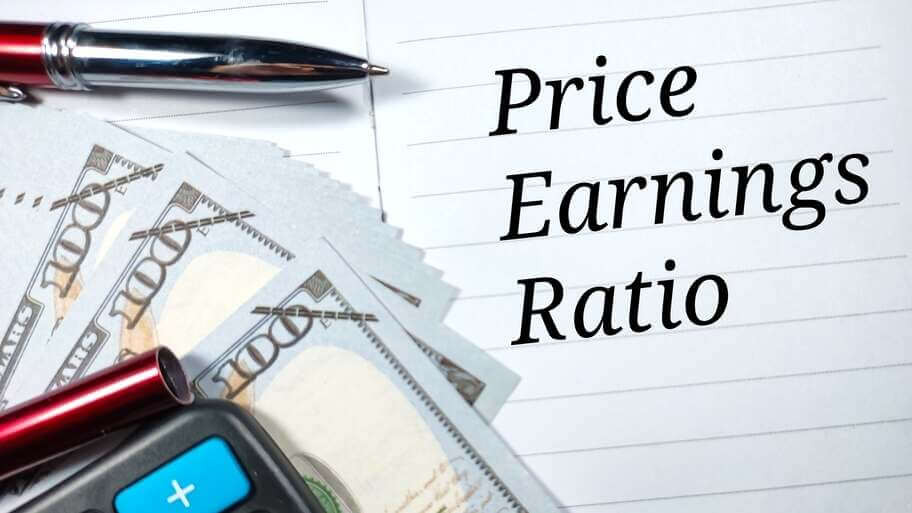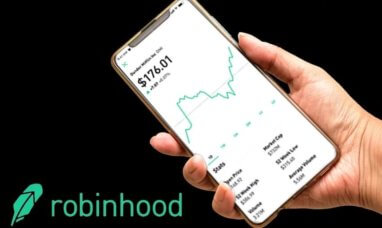When determining the value of a stock, investors use the price-to-earnings ratio. It is one of the most utilized metrics to evaluate stocks and is a good way to determine if a stock’s price is overvalued or undervalued. Here’s how to use PE in your investment strategy, and how it will help develop your portfolio.
Retail traders should become just as familiar as corporate investors with a PE ratio’s meaning. The PE ratio shows us what the market is willing to pay in exchange for a stock based on past (or future) earnings.
There are many tools and dashboards investors use to find the PE ratio, earnings per share, and other information without having to do the calculations. The website Tradingview provides one of the most robust interfaces to view statistics about stocks. There are other ways to calculate PE ratio online. Almost all websites that display up-to-date stock information calculate the PE ratio for you and list it underneath the chart.
PE Ratio is the cost per share of a stock divided by its earnings per share (EPS).
Companies with the highest PE ratio are those that have established growth. Investors expect future growth, which raises the PE ratio.
The PE Ratio
Investors determining a PE ratio look at the current price of a stock and compare it with the company’s EPS, or earnings per share. PE ratio can be estimated on a future projected (forward) basis or a backward (trailing) basis (over a 12-month period).
Before we can calculate a company’s PE ratio, we need to know the earnings per share.
Earnings per share:
EPS is an indicator of a company’s ability to produce profits for shareholders. Calculating EPS is important for investors is because it essentially tells you how much of the company’s profit your shares contain.
One of the ways to calculate EPS is by subtracting preferred dividends from the company’s net income, then dividing that amount by the number of shares outstanding. Preferred dividend holders have contractual rights to dividends, so it’s important to subtract these dividends from the net income.
The basic EPS calculator:
EPS= N (Net Income) – PD (Preferred Dividends)
_____________________________________
Average Shares Outstanding
Let’s use an example:
Mike’s Confectionary Company is publicly traded with $1-million in net income in the third quarter of 2021. Let’s say the company will pay $250,000 in dividends to shareholders while there are 11,000,000 shares outstanding.
With that info, Mike’s Confectionary Company’s EPS would be:
($1,000,000 – $250,000) / 11,000,000 = 0.068. So, each share would deliver its owner $0.068.
If you owned 10,000 shares of Mike’s Confectionary Company, you would earn $680 in dividends in Q3 of 2021.
Be wary! Some companies manipulate their earnings per share calculation. Sometimes it’s not their fault, such as when there are expenses, amortization, or depreciation. These get subtracted from net income in large amounts at various quarters, so using the net income to calculate EPS greatly affects the result. Google “PE ratio” and you can find a calculator to help conduct your own estimation of a stock’s value.
Another thing to watch out for when looking at EPS is a company changing the number of outstanding shares. Share buybacks, stock splits, reverse stock splits, and share issuances all affect the net income minus dividends calculation.
High PE vs. Low PE
So you’ve calculated the PE of a company. What does the value actually mean to you?
If PE is very high (ie, 30 or more), it might indicate one of two things:
1) The stock is overvalued, which means it might be a stale investment in some circumstances.
2) Investors are putting a high value on the stock because they project that it will generate higher returns in the future.
Using a Price-to-Earnings Ratio to Determine if an Investment is “Good”
Caution is warranted when using PE ratio to value stocks. Average PE ratios vary from $15 to $30. Some stocks, like semiconductor company Nvidia Corp. (NASDAQ:NVDA), currently have a PE ratio over 90. That means that for every $1 Nvidia earns, investors are paying $90. Determining whether or not it’s a sound investment is up to the individual investor. In this case, the stock has gone up. At the time of writing, NVDA is trading at $813.86 per share with a PE ratio of 96.51.
In this case, the PE ratio increased proportionally to the stock price. While this is not always the case, the Nvidia example is great because it’s a high-value growth company. The product they make is in extremely high demand, and recent market events have caused this demand to skyrocket.
A “good” investment for beginners must meet many criteria, and the term can mean different things to different people. A high PE ratio for a company that has solid fundamentals, is well established, and is a market leader, might mean good returns for growth investors over the long term.
In the case of Nvidia, we can conclude that the stock is trading at 90 times what the company earns for each share. We must compare its PE ratio to that of its peers in the semiconductor industry. Despite massive gains in recent months, the stock may still be undervalued compared to an aggregate PE of 118.89 based on its peers.
What if a company has no PE ratio available? If you try to calculate it yourself, you might get a negative number. This simply means the company is not profitable.
Sometimes, a negative PE means that the company is still paying off debt or that recent economic events have affected investment and share prices. If a company has a consistently negative PE ratio, it could mean it’s close to bankruptcy. Invest in companies with a negative PE at your own risk.
However, a negative PE ratio could simply indicate changes in accounting practices or fluctuations due to paying off debt. Maybe the company finished paying off debt in one quarter, so it didn’t have positive earnings to report. Subsequent reports in the fiscal year may have a positive PE ratio instead.
Various sectors require specific analysis. In pharmaceuticals, billions are poured into research, so pharmaceutical companies might report losses for years until the drug is finally released. The rising stock prices in these cases are due to high growth expectations for the coming years.
Sometimes, a newer company that just IPO’d might have just launched or has not had earnings yet. Use your discretion.
Finally, Make Sure to Compare PE Ratios
PE ratios are a good indicator of the overall value of a company based on how much (or how little) it earns. So, the best way to utilize PE’s is to compare stocks.
A fantastic way to quickly see if a stock is overvalued is by comparing its PE to others in its industry. A low PE could mean that the company’s stock is priced very well for how much it earns in profit. In the above example, NVDA had a massively higher PE than the average S&P 500 company, which has a PE ratio of about 12 to 15. This highlights how much PE can vary across industries.
It is also important to consider business cycles. Industries have different business cycles and will report different earnings at various times of the year. Watching indexes and comparing your picks to other companies in the same industry with similar share prices is an excellent way to practice using the PE ratio as part of your investing strategy.
Featured Image: Twenty20






